PPC: It’s the new black for companies looking to gain a scalable edge over their competitors. Or is it? Surely, you can dump $10,000 into Google Ads and expect to dominate your competitors’ digital landscape by following the best practices provided by Google Help articles, right? Not necessarily.
Let’s face it: PPC ads are tempting. Occupying that sweet #1 spot in Google’s Search Engine Results Page (SERP) for your industry’s top queries sounds like the ultimate hack to getting that upper hand over your competition. Who can blame this thought process?
71% of businesses now have a website in 2023, so competition amongst search engines is at an all-time high. However, it’s important that you approach your competitor’s PPC strategy with the correct best practices and resources to ensure that your ad dollars are effectively used.
Don’t worry; we’ve got you covered. In this guide, we’ll review the following:
- What is a competitor PPC analysis?
- Importance of a competitor PPC analysis
- Acronyms you’ll hear when conducting a competitor PPC analysis
- Framework of a competitor PPC analysis
- Out-of-the-box tools and strategies
- Conclusion
What is a Competitor PPC Analysis?
A competitor PPC analysis is an in-depth look at the current state of your competitors’ pay-per-click (PPC) strategy and what exists for prospects within your industry to see. Competitor PPC analyses help you to understand the existing competitor landscape in your industry, where your competitors are winning and failing, and opportunities upon which you can capitalize.
Depending on your needs as a business, a competitor analysis can be as simple as a Google search query to identify what your competitors’ ads look like or as complex as a deep dive into short and long-tail keywords for which your competitors are ranking across all search engines. Regardless, a competitor analysis will help you shed light on a crucial aspect of your industry that typically goes unnoticed.
The Importance of a Competitor PPC Analysis
A comprehensive competitor PPC analysis can take time. Before you dedicate your efforts to compiling a list of the competitors running ads under every last search term in your industry, it’s great to understand why a competitor PPC analysis is beneficial to your business’s growth.
Language
Understanding the tone of voice used to speak to your prospects is crucial. After all, the words in your ad are the first thing your target audience sees when it appears in the SERP. Spending merely an hour of your time reading through copy in your competitors’ ads can give you an idea of what your audience is already reading and how you can improve it to increase your conversion rates.
Budgeting
Identifying weak spots in your competitors’ PPC strategies may help you decide where to allocate your ad dollars in the future. Is there a new, relevant, long-tail keyword for which your competitors are forgetting to show ads? Maybe it’s a good idea to shift your marketing budget to capture new prospects searching this keyword instead of leaving your budget in a space that’s already congested.
Keywords
The example above is one of many that may come out of a competitor PPC analysis. Keywords are the foundation of every PPC strategy, so understanding the keywords upon which your competitors are already bidding and your industry’s relevant, valuable keywords will help you navigate the rest of your PPC marketing strategy.
Existing Competition
While a competitor PPC analysis is extremely helpful for technical PPC questions, it can also help you gain insight into other elements of your competitor landscape.
- Who are the competitors in my space?
- What digital marketing strategies are my competitors using on popular search engines?
- When do my competitors advertise, such as a specific time of day?
- Where do my competitors advertise within each search engine?
- Why are my competitors using their specific PPC strategy?
These are all questions you might be asking yourself that can easily be answered through a competitor PPC analysis.
Acronyms You’ll Hear When Conducting a Competitor PPC Analysis
It’s ironic how the purpose of acronyms is to make text more easy to read and understand when, especially in the PPC space, loads of acronyms only make people feel more confused. That’s why we put a glossary together on how to navigate the confusing world of PPC lingo. Below are several terms you may encounter when conducting your competitor PPC analysis:
PPC: Pay-Per-Click; the model that search engines such as Google and Bing follow to charge advertisers every time their ads are clicked. For example, in order to show an ad for the keywords, “shoe stores in nyc,” advertisers are charged when someone clicks on the ad shown for this keyword, not for the ad’s appearance. Whenever you hear the acronym “PPC,” it is usually used to refer to search engine advertising practices.
SEM: Search Engine Marketing; the term that refers to the broader digital marketing practices of advertising on search engines. SEM encompasses PPC and Search Engine Optimization (SEO), the organic, unpaid side to SEM that involves optimizing the technical components of a website to rank higher in a SERP and, more importantly in the context of this article, closer to PPC ads located at the top of the SERP.
CPC: Cost-Per-Click; the cost that an advertiser has to pay for each click that their ad receives. Since PPC advertising follows a pay-per-click model, understanding CPC and the costs associated with advertising on search engines is essential.
RM: Remarketing; the tactic that involves showing ads to your visitors who do not convert. If you’d like to learn your competitors’ remarketing strategy, click on one of their ads, and keep an eye on those you see in the future. If your competitor has remarketing campaigns set up, there’s a high chance that you will see their ads in the form of a banner when scrolling down a web page or image ad on your favorite social media platform.
CTR: Click-Through-Rate; the rate at which your ads were clicked after they were shown. This can be calculated by dividing your ads’ clicks by the number of impressions your ads received. For example, if your ad received 100 clicks and 1000 impressions in 2 weeks, then your CTR for those two weeks would be 10%. In the context of a competitor PPC analysis, if your ads’ CTRs are being the industry average, you probably have a leg up on your competition.
IS: Impression Share; the ratio of the number of impressions received on your ad versus the total number of impressions you could have received. When conducting a competitor PPC analysis, Impression Share is an important metric for which to account, as a high impression share can indicate that your ads are showing more than others in your category. If a keyword in your category has a high impression share for your brand and search volume, you may want to consider adding it to your list of targeted keywords.
ROAS: Return-On-Ad-Spend; the money generated from the amount spent on advertising. This is a percentage that can be calculated by dividing ad revenue by amount spent on ads. If your ads received $1000 in revenue and spent $100 on clicks, then your ROAS is 10x. ROAS is helpful at understanding how much money was gained or lost after running advertising campaigns.
Whether setting up your first PPC campaign or presenting your competitor PPC analysis to internal stakeholders, take advantage of our common PPC acronyms infographic and download yours below!
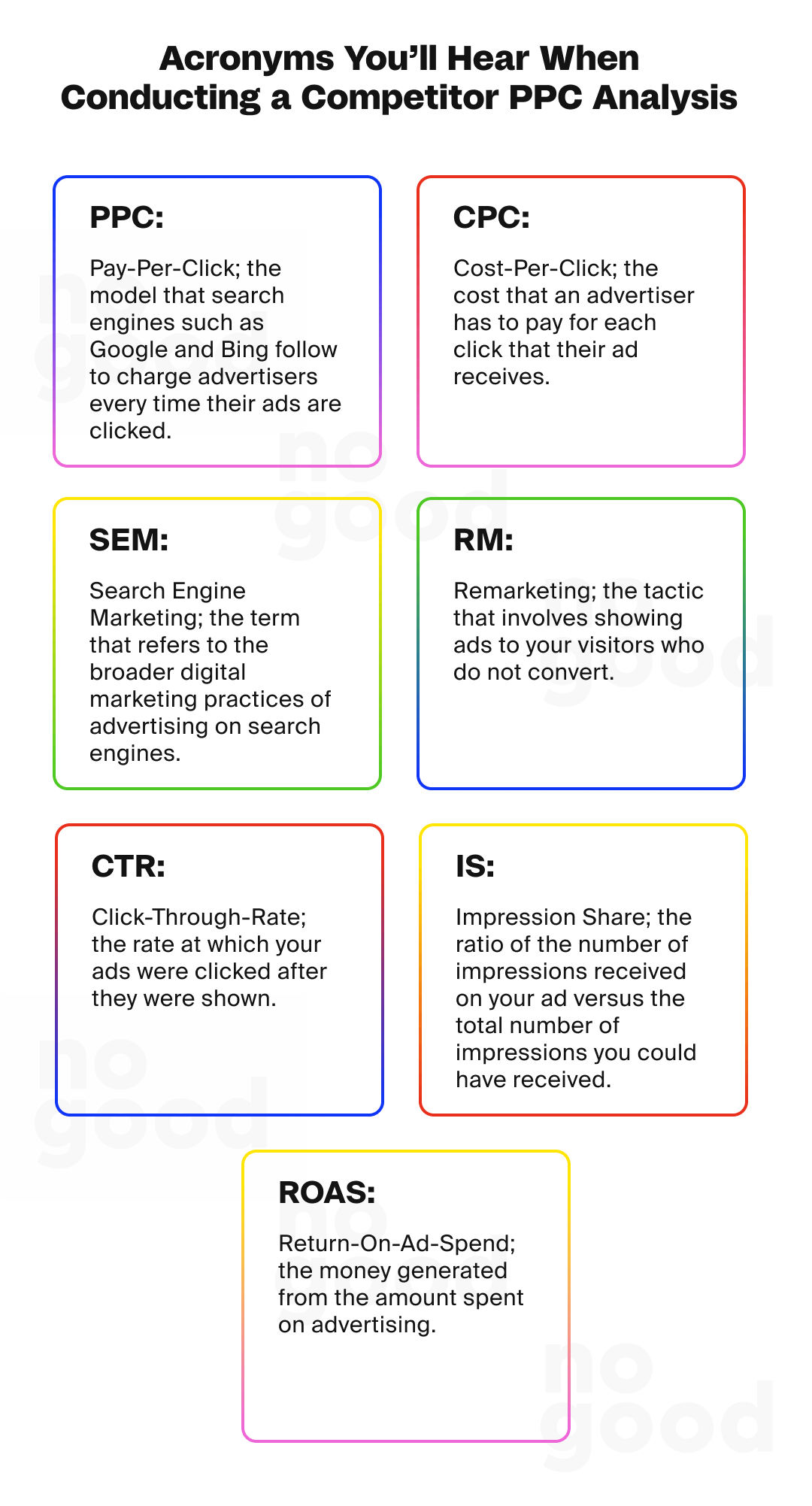
The Framework of a Competitor PPC Analysis
1. Determine Who Your Competitors Are
Depending on your business’s growth stage, you may or may not know who your competitors are. Compiling a list of your competitors will serve as the starting point for your competitor PPC analysis.
2. Compile the Keywords That Your Competitors Are Targeting
Like we mentioned before, keywords are the foundation of PPC advertising. Without a concrete list of relevant keywords, launching your PPC campaigns is impossible.
To understand the keywords that your competitors are targeting, you can go one of two different routes: the route with a tool and the route without a tool.
In the route with a tool, you may end up having to spend some money, typically around $100 per month. There are several free tools available, such as Ahrefs, SEMrush, or SpyFu, that give surface-level insights into the keywords for which your competitors are showing ads if you aren’t interested in spending any money.
In the route without a tool, you will follow the traditional steps of searching keywords relevant to your business’s offering and seeing if your competitors are showing ads for them. If choosing this route, you will want to compile a list of relevant keywords and, when searching these terms on a search engine, ensure you scrape the entirety of page 1 to see where your competitors are placing ads throughout the page, as placement of ads can typically mean different CPCs.
3. Investigate Your Competitors’ Ads
Over the years, search engines like Google have provided a plethora of capabilities to advertisers when it comes to building out PPC ads. Luckily for you, when doing a competitor PPC analysis, this provides you a deep level of insight into your competitor’s strategy. When researching your competitor’s ads, you’ll want to pay close attention to several factors:
Tone of Voice
What messaging are your competitors highlighting? Are there certain value props that are more appealing to your audience that competitors are using or missing out on? What emotions are they triggering? Are they utilizing any specific grammatical constructions, such as passive voice?
Calls to Action (CTAs)
Are your competitors using any specific CTAs? Check to see if there is any differentiation among the CTAs that your competitors are using. Maybe certain competitors are incentivizing visitors to provide them with their contact information in exchange for downloadable case studies. Maybe certain competitors are simply asking visitors to add products to their cart, or schedule demos.
Ad Elements
Are your competitors’ ads using any elements outside of traditional body text and a headline? Elements such as sitelink extensions, phone numbers, structured snippets, and lead forms are all helpful at increasing engagement for your ads. If your competitors are not utilizing any ad extensions, this could lead to higher engagement and conversion rates for your ads.
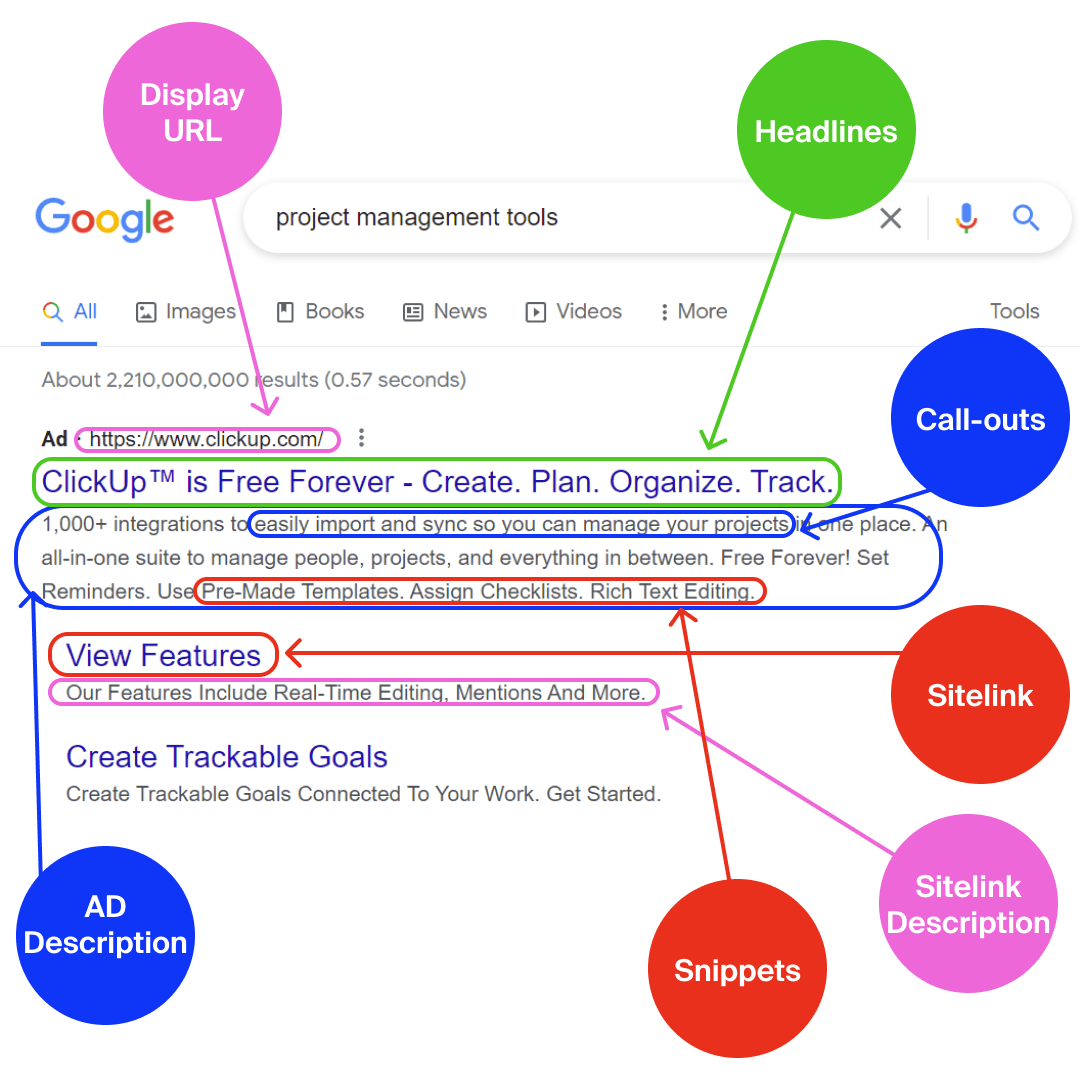
4. Examine Your Competitors’ Landing Pages
We’ve talked heavily about the importance of an ad’s structure, but what about the post-click experience? Having a seamless, user-friendly landing page is crucial to ensuring that visitors complete your most sought-after action: a conversion.
When examining your competitors’ landing pages, a helpful framework to follow is the AIDA framework. The AIDA framework serves as a checklist for advertisers to ensure that their landing page is optimized to its fullest potential. The AIDA framework goes as follows:
A(ttention) – Does the landing page grab the users’ attention to ensure that they don’t navigate away?
I(nterest) – Does the landing page offer what the user is interested in?
D(esire) – Does the landing page create a desire for the user to convert?
A(ction) – Does the landing page enable the user to complete your desired action?
A competitor’s landing page that does not follow the AIDA framework provides you a significant edge against your competition. Consider formatting your landing page to go above and beyond the AIDA criteria.
5. Conclude with a SWOT (Strengths, Weaknesses, Opportunities, and Threats) Analysis
Assess your company’s internal capabilities versus the external market conditions in the PPC realm. Identify your company’s strengths and weaknesses against the competition, as well as opportunities and threats. Leverage the findings from the steps above and use your SWOT analysis to formulate your PPC strategy going forward.
Congratulations on reaching the end of the competitor PPC analysis framework! To reward you for your hard work, we’ve designed a checklist consisting of the steps above to ensure that you surpass your competition. Feel free to download the checklist below and kickstart your competitor PPC analysis today.
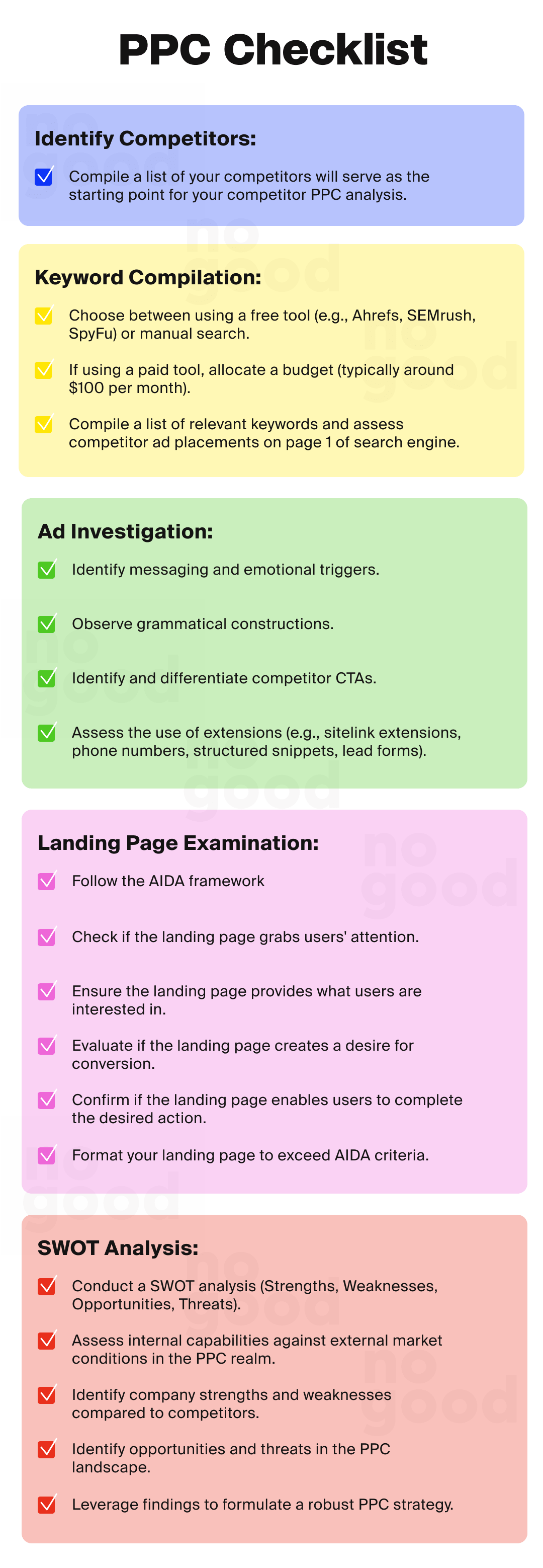
Out-of-the-Box Tools and Strategies
Before you go, we wanted to leave you with an arsenal of tools and strategies that you (probably) didn’t know to ensure the success of your next competitor PPC analysis. And good news, they’re all free!
Google Ads Transparency Center
Similar to how you can utilize Facebook’s Ad Library to view competitor ads on Facebook, you can do the exact same thing on Google; it’s just more hidden. Typical Google, right?
To access the Google Ads Transparency Center, you can follow the steps below:
- Research a competitor’s ad with a relevant keyword. If you are in the plumbing business, try “plumbing services.”

- Locate the 3 dots next to the display URL above the headline and click.

- Click “see more ads this advertiser has shown using Google”
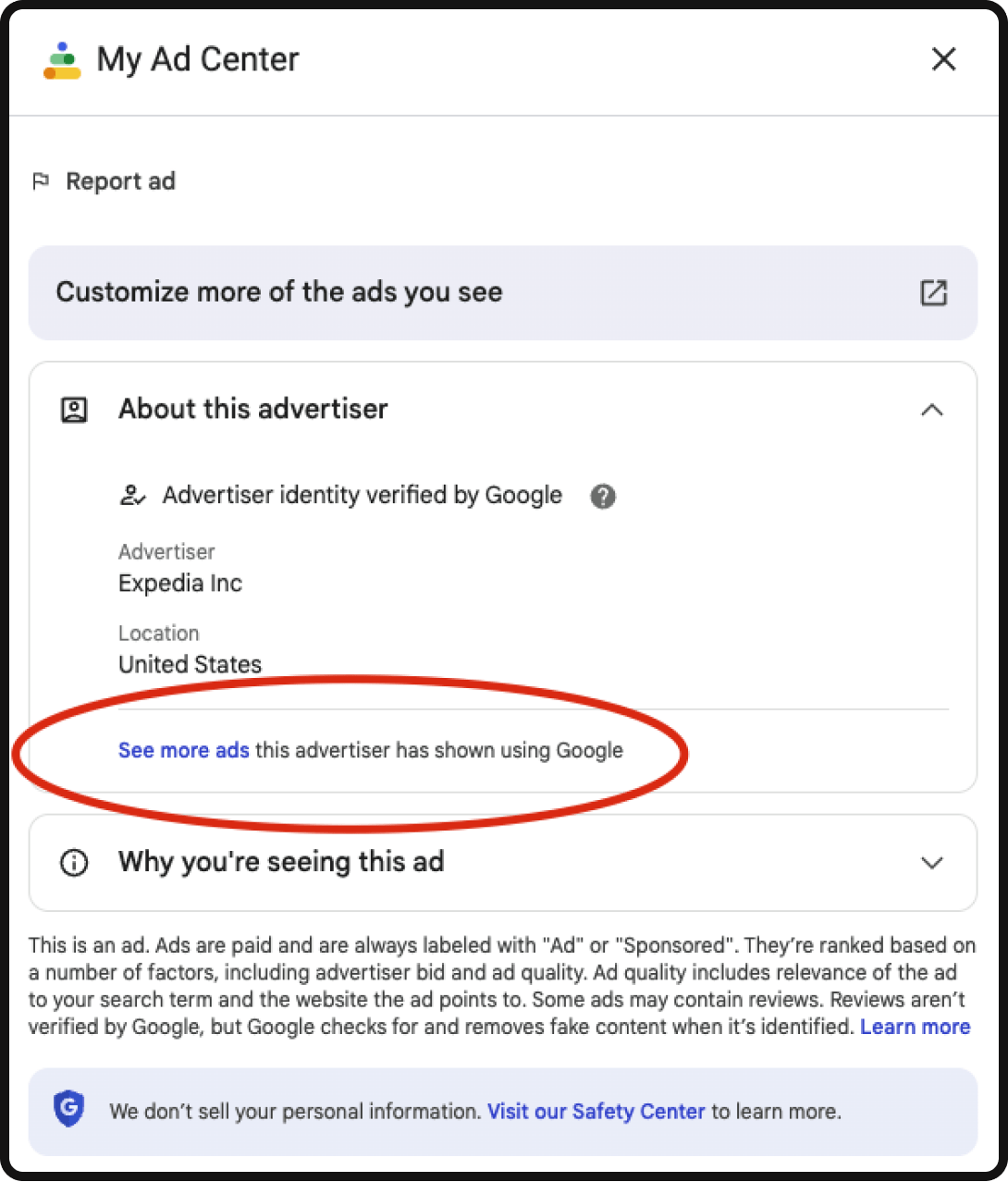
- Type the competitor you are interested in seeing ads for and search
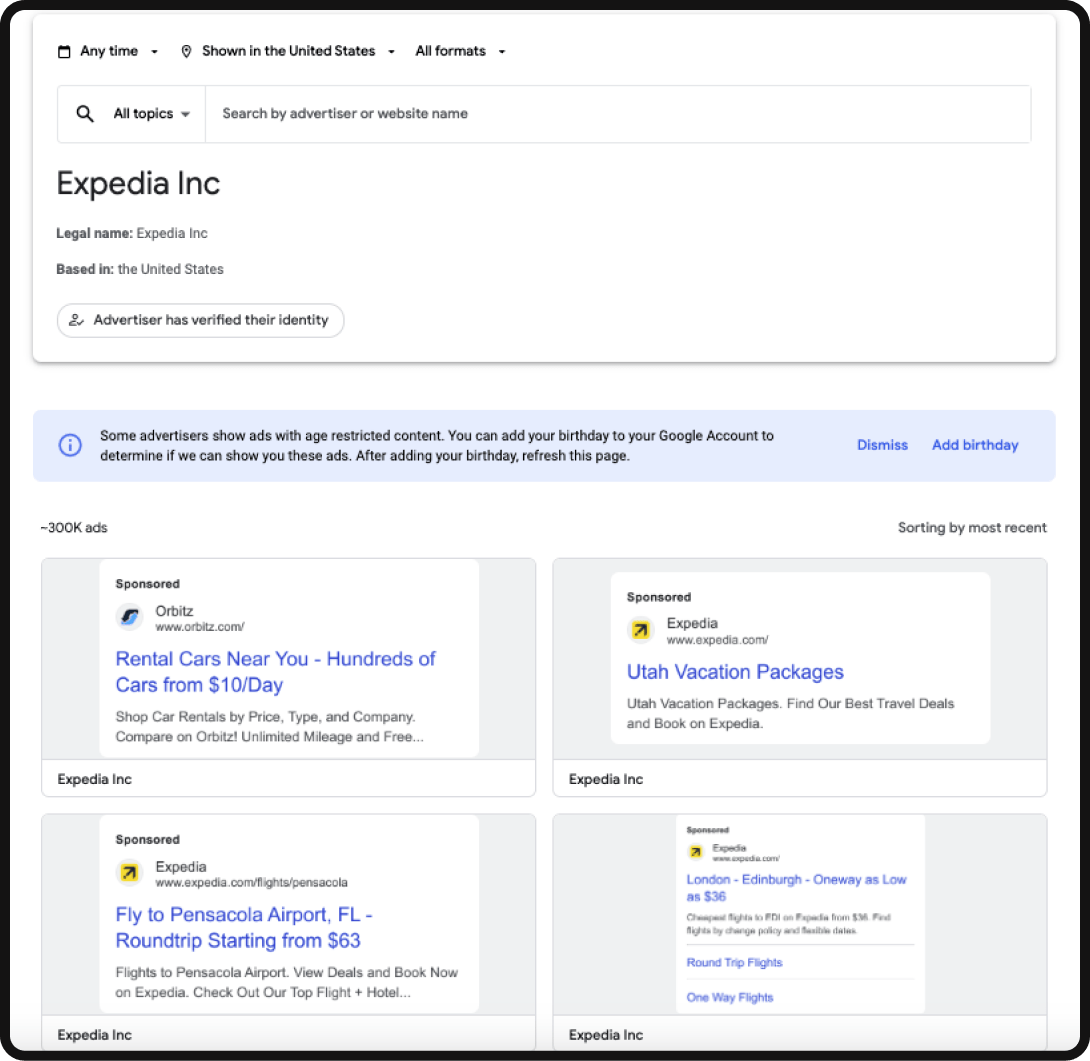
Competitor Ad URLs
If you’re looking for the source of truth to your competitor’s PPC strategy, it might be located in their ad’s URL. Despite this process involving a bit more manual labor, it can provide substantial insights if you’re able to connect the dots.
The process is simple: find one of your competitors’ ads and click on it. Go into the URL and see if there are any UTMs following your destination URL.
If your competitor has any UTMs set up, they will contain information like the category of keywords which they are targeting, if they are using Google Click IDs for tracking purposes, and the way in which they categorize their campaigns.
Whether formulating your campaign structure or identifying gaps in your competitors’ ads, URLs typically contain valuable information behind the curtains.
ChatGPT
It wouldn’t be a 2024 blog if we didn’t include a tip on how to leverage AI in your marketing practices. Luckily enough, ChatGPT and other generative AI tools provide countless ways for marketers to gain valuable insights that search engines are unable to provide as of yet.
One way that advertisers can utilize ChatGPT for their competitive PPC analyses is by dissecting the structure of an ad or landing page. With the advancements that OpenAI has brought to ChatGPT, ChatGPT-4 is able to analyze the contents of a landing page and PPC ad if you paste the URL into its message bar. Simply ask ChatGPT to analyze the contents of a landing page or ad and identify key points such as sentiment, tone of voice, language, value props, and CTAs.
The best part about ChatGPT is that it’s fully customizable. Not only can you feed it different queries, but you can craft a prompt that warrants a tailored answer.
Conclusion
The PPC world is an ever-changing one, so it is essential that advertisers stay on top of their competition to ensure they don’t fall behind. In this blog, we explored the ways that advertisers like you can gain a competitive edge against other businesses in their space.
With advancements in technology and consumer behavior, there is no better time to understand your competitors’ gaps, ad strategy, and existing PPC lingo. Luckily enough, tools and guides exist to provide a deeper level of insight that will enable advertisers to yield scalable growth for their businesses.





